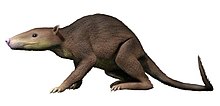Zalambdalestidae is a clade of Asian eutherians occurring during the Cretaceous. Once classified as Glires, features like epipubic bones and various cranial elements have identified these animals as outside of Placentalia, representing thus a specialised clade of non-placental eutherians without any living descendants, and potentially rather different from modern placentals in at least reproductive anatomy.[1][2]
| Zalambdalestes Temporal range:
| |
|---|---|

| |
| Zalambdalestes lechei skull and lower jaw, Museum of Evolution Warsaw. | |

| |
| Life reconstruction of Zalambdalestes lechei | |
| Scientific classification | |
| Domain: | Eukaryota |
| Kingdom: | Animalia |
| Phylum: | Chordata |
| Class: | Mammalia |
| Clade: | Eutheria |
| Order: | incertae sedis |
| Family: | †Zalambdalestidae Gregory & Simpson, 1926 |
Taxonomy
editThe exact position of Zalambdalestidae within Eutheria varies, though they are generally agreed to be more basal than zhelestids.[3] Currently, the clade includes the genera Alymlestes, Anchilestes, Barunlestes, Kulbeckia, Prozalambdalestes, Zalambdalestes, Zhangolestes and Zofialestes.[4]
Palaeobiology
editZalambdaltestids were insectivores, having zalambdodont molars much as various modern insectivorous species. They are uniquely suited to a saltatorial, cursorial lifestyle, bearing long, semi-digitigrade limbs and a spinal column similar to that of modern lagomorphs.[5] Like most non-placental mammals, the presence of epipubic bones probably meant that they gave birth to poorly developed young much like modern marsupials and monotremes, though a study on multituberculate reproduction may suggest they and other early eutherians reproduced like modern placentals.[6]
A study on Zalambdalestes suggests they had a unique axial morphology. This allowed for quick prey capture, and may suggest they had spines or bristly fur in life.[7]
References
edit- ^ Wible, John R.; Rougier, Guillermo W.; Novacek, Michael J. (2005). "Anatomical evidence for superordinal/ordinal Eutherian taxa in the Cretaceous". In Rose, Kenneth D.; Archibald, J. David (eds.). The Rise of Placental Mammals: Origins and Relationships of the Major Extant Clades. Johns Hopkins University Press. pp. 15–36. ISBN 9780801880223.
- ^ Wible, J. R.; Rougier, G. W.; Novacek, M. J.; Asher, R. J. (2007). "Cretaceous eutherians and Laurasian origin for placental mammals near the K/T boundary". Nature. 447 (7147): 1003–1006. Bibcode:2007Natur.447.1003W. doi:10.1038/nature05854. PMID 17581585. S2CID 4334424.
- ^ Archibald, J. David; Averianov, Alexander (2012). "Phylogenetic analysis, taxonomic revision, and dental ontogeny of the Cretaceous Zhelestidae (Mammalia: Eutheria)". Zoological Journal of the Linnean Society. 164 (2): 361–426. doi:10.1111/j.1096-3642.2011.00771.x.
- ^ Lopatin, A. V.; Averianov, A. O. (2024). "New Early Cretaceous zalambdalestid stem placental mammal from Mongolia and evolution of Zalambdalestidae". Journal of Vertebrate Paleontology. doi:10.1080/02724634.2024.2384601.
- ^ Chen, Meng; Wilson, Gregory P. (2015). "A multivariate approach to infer locomotor modes in Mesozoic mammals". Paleobiology. 41 (2): 280–312. Bibcode:2015Pbio...41..280C. doi:10.1017/pab.2014.14. S2CID 86087687.
- ^ Urton, James (July 25, 2022). "New study challenges old views on what's 'primitive' in mammalian reproduction". UW News. University of Washington. Retrieved April 6, 2024.
- ^ Arnold, Patrick; Janiszewska, Katarzyna; Li, Qian; O'Connor, Jingmai K.; Fostowicz-Frelik, Łucja (April 16, 2024). "The Late Cretaceous eutherian Zalambdalestes reveals unique axis and complex evolution of the mammalian neck". Science Bulletin. doi:10.1016/j.scib.2024.04.027.